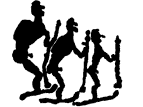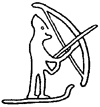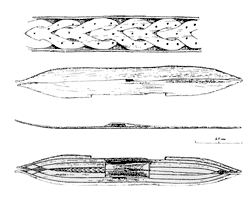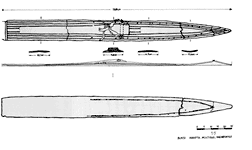Ancient skiing and archery
Ancient skiing
The Fennoscandic territory has a great amount of ancient ski finds. Skiing was a must for our hunting forefathers which provided peoples of the South with furs. The finds consist of different ski types depending on dating, find location and usage. Below you see a 4000 years old stone carving from northern Carelia. This carving probably was a part of a fertility cult. Near you see a skiing archer, which is carved on a Viking Age rune stone in Sweden.


Then a find from Kinnula, Finland. This decorated ski is dated to early Viking Age (decoration is enlarged in upper part of picture). Notice that its length is only 101 cm. The width is 12,5 cm. One explanation of the shortness is that people that used them were smaller than nowadays. Short and wide skis, however, are well suited for hunting in terrain with thick vegetation and deep snow.

Below is a find from Mantta, Finland. It is dated to the 6 th century. The bottom of the ski was covered with fur. This gives better hold when skiing on broken ground. The going is also more silent which is important when hunting. You see a drawing of the ski find with dimensions (length 161 cm, width 15 cm) and a detail photo of the foot space.


Ancient archery
With a wooden bow the ancient hunter and fighter was an effective and silent element of the nature. Below you see a rock painting in Astuvansalmi, Finland. It shows a female archer, who is hunting elk. It is not difficult to make a primitive, but usable, bow. The ancient bow had usually an unsophisticated curving.

Roughly the length of the bow should be somewhat shorter than the length of the archer. The bow find from Paltamo in Finland (dating c. 300 B.C.) has a calculated length of 142 cm. This, and the Viking Age bow find from Kärsämäki in Finland, are both more flat in cross section than older types. Below you have a sketch of this type of bow in unstrained condition.

It is worth paying attention to the quality of the wood. In cross section the annual rings should be symmetric and the wood fibres should parallell the back of the bow. Wood of ash is good but many other bow materials are usable. The thickness of the bow determines the strength that is needed for full draw and should be adjusted to the strength of the archer’s arm.
The arrows can be made of bird cherry and should have a length of about 0,43 bow length. For feathering use bird feathers. The ancient trapper used arrows with blunt heads not to destroy the precious fur of small animals, as squirrels and sabels. These knocked the animal unconscious and gave the trapper enough time to run (or ski) and pick it up and kill it. Below you see a set of blunt arrowheads used by Finnish-Ugrical tribes.


Fredrik KOIVUSALO
www.qnet.fi/rus-project/

